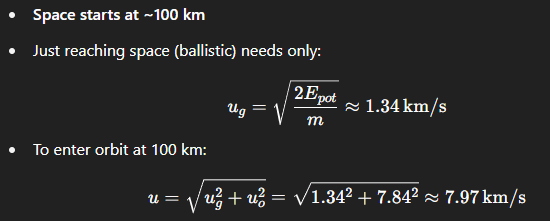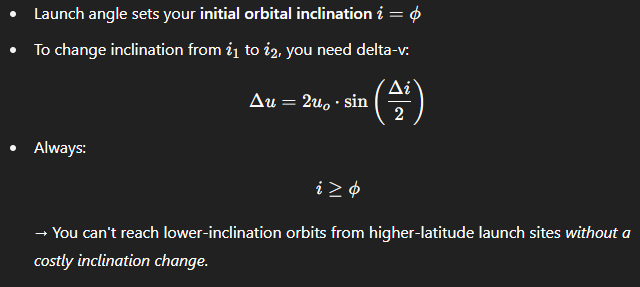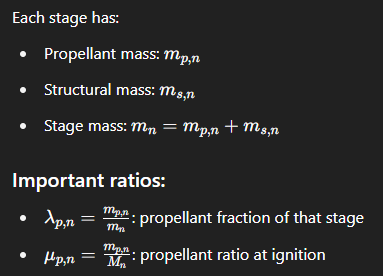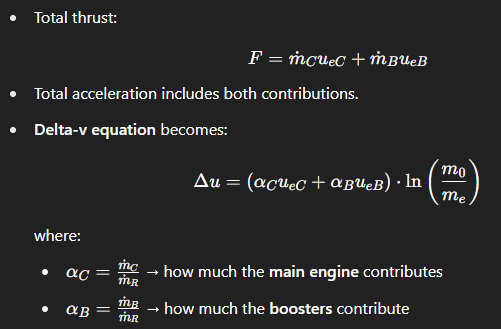L02 - Fundamentals of Rocket Propulsion
1/33
There's no tags or description
Looks like no tags are added yet.
Name | Mastery | Learn | Test | Matching | Spaced |
|---|
No study sessions yet.
34 Terms
Why is momentum conserved in the rocket-exhaust system in the absence of gravity?
Because there are no external forces, the total momentum remains constant. The backward momentum of the exhaust balances the forward momentum gained by the rocket.
The system consists of the rocket and the exhaust gases.
Total momentum is conserved (no external force like gravity).
The rocket loses mass but gains velocity.
How is thrust related to the exhaust velocity and the rate of fuel consumption?
Thrust is the product of the mass flow rate of the exhaust and the exhaust velocity:

What does the Tsiolkovsky rocket equation tell us about the velocity change of a rocket?
It tells us how much velocity change (ΔuR) a rocket can achieve based on its initial and final mass and the exhaust velocity.

What is the propellant mass fraction, and how does it affect delta-v?
It is the ratio of propellant mass to initial mass. A higher fraction allows more acceleration, but practically, it's limited due to structure and payload.

Why is the delta-v theoretically unlimited, and why is it limited in practice?
Because in theory, if all mass is fuel, you get infinite delta-v. But in practice, the rocket must carry structure and payload, so μp<1
Real rockets always have structure + payload = dry mass.
Why is a higher exhaust velocity beneficial for rockets?
Because it allows the rocket to achieve higher delta-v with less fuel, improving efficiency.
Higher ue → more efficient propulsion.
What is specific impulse and why is it important?
Specific impulse (Iₛₚ) tells how efficiently a rocket uses fuel. It’s the thrust per unit mass flow per gravity. Higher Iₛₚ means better fuel efficiency.

How does gravity affect the rocket's vertical velocity?
Gravity causes an additional loss: the rocket must fight against it during the burn. So we subtract g⋅tB from the vertical velocity gain. 𝑡𝐵 : burn time

What are the three contributions to total Δu when launching with gravity?
Propulsion (blue): actual engine-generated delta-v
Gravitational losses (red): energy lost fighting gravity
Free fall term (green): vertical motion during burn
Why do rockets experience higher gravity losses with long burn times?
Because they spend more time fighting gravity. That’s why rockets use high thrust in the first stage to minimize this time.\
Important insight:
More burn time → more gravity losses
Steeper angle (θ → 90°) → more vertical fight → more losses
Graph: Δu vs μₚ . what happens for different flight angles. Why?
At 90° (vertical): largest gravity losses → higher fuel needed
At 0° (horizontal): minimal gravity effect, best fuel efficiency
Because the rocket has to work directly against gravity the entire time, causing larger gravity losses and requiring more fuel.
Trajectory of Ariane 5
Why does the altitude decrease slightly during the pitch-over maneuver?
Vertical Ascent
Increase altitude
Low velocity
Pitch-Over / Gravity Turn
Begin tilting to gain horizontal speed
Temporary Altitude Drop
Due to turning into a more efficient trajectory
Second Stage Ignites
Velocity continues increasing
Payload Release
Final velocity and orbital insertion
Because the rocket is rotating to increase horizontal velocity. It temporarily sacrifices altitude to follow a more efficient orbital path.
What is the Delta-v Required to Reach Space?
Why is much more delta-v needed to enter orbit than just to reach space?
Because reaching space only requires vertical ascent, while orbit requires high horizontal speed to stay in motion around Earth.
Needed delta-v for space tourism and sounding rockets is significantly lower than for reaching orbit

Modification of needed change of velocity (needed delta-v)
What are the losses and gains?
What happens if you launch westward?
Losses:
Gravity losses: 1–1.5 km/s
Maneuvering, air drag, and safety margins add more
Gains:
Earth’s rotation helps!
Launching eastward from Kourou (near equator): −0.461km/s
You must fight Earth’s rotation, so your required delta-v increases significantly. That’s why rockets usually launch east.
Changing Orbital Inclination
Why is it expensive (in terms of delta-v) to change orbital inclination?
Because you have to change the direction of your velocity, not just its magnitude. This requires a lot of energy.

Why is Kourou (French Guiana) a preferred launch site?
Because it’s close to the equator, allowing rockets to fully benefit from Earth’s rotation, which reduces required delta-v and fuel use.
Closer to equator = better delta-v efficiency
Higher latitude = more limited orbit options
Staging of rockets
Mass ratios of rockets
How is the change in velocity (Δu) related to the propellant mass ratio?
m0=ms+mp+mpl :total mass (structure + propellant + payload)
It's logarithmically related: more propellant (higher μp) → higher Δu, based on the equation

Advantages of Staging
Why do we use multiple stages in rockets?
Goal: Maximize Δu
To do that:
Maximize μp
Minimize μs (structure)
Solution: Staging!
Drop off empty stages to reduce structural weight.
To minimize structural mass as we go higher. Dropping stages (staging) allows us to keep accelerating with less mass, increasing efficiency and delta-v.
Tandem (Serial) Staging
What’s the difference between λₚ and μₚ in a staged rocket?
λp: propellant fraction within the stage
μp: propellant ratio compared to total mass at ignition (includes upper stages)

Why does the first stage of a rocket usually have the largest mass?
It needs to provide the most thrust to escape gravity and carry the mass of all upper stages.
Optimum Number of Stages
What are the facts of more stages?
Why don’t we use more than 3–4 stages?
More stages:
→ Better efficiency (higher payload ratio)
But: diminishing returns after 2–3 stages
More complexity = higher cost and risk
Because after 2–3 stages, gains in payload ratio are small, but complexity and cost increase a lot.
Optimizing Delta-v Split Between Stages
How do you minimize the initial mass of a staged rocket?
Why is the optimal total mass lowest when the second stage provides more delta-v?
Let the stage with higher exhaust velocity (ue) provide a larger share of total Δu.
Because the second stage has a higher exhaust velocity, meaning it is more efficient. Giving more of the delta-v task to the more efficient stage reduces the total initial mass.
Optimization of main and upper stages

Why are upper stages optimized for specific impulse rather than thrust?
In space there's no atmosphere or gravity to fight — efficiency (high Isp) becomes more important than raw thrust.
Parallel Staging – What is it?
Advantages, Challenges
Boosters (side rockets) and main engine fire at the same time.
✅ Advantages:
High thrust → high acceleration → can lift heavy payloads.
Thrust and performance can be adjusted flexibly.
⚠ Challenges:
High structural load → more stress on the rocket.
Very high acceleration → may damage payload.
More air drag (aerodynamic resistance).
Engine nozzles must work well at all altitudes (no time to optimize).
Delta-v in Parallel Staging (with boosters)
In parallel staging, what determines how much delta-v the boosters contribute?
Both the main engine and boosters contribute to thrust.
The mass flow rate of the boosters and their exhaust velocity.

General Rules for Rocket Staging – Summary
Main stages should have high thrust:
To leave Earth quickly and fight gravity.
Upper stages should have high exhaust velocity:
Better efficiency in space.
Stages with higher ueu_eue (better engines) should provide more of the delta-v.
Upper stages should be lighter than main stages.
Why should upper stages have higher exhaust velocity than main stages?
Because in space we don’t need high thrust, we need efficiency. High exhaust velocity means better fuel use and more delta-v for the same amount of mass.
Operation of Upper Stages why critical
Ignition under vacuum conditions
Multiple ignition for multiple payloads and missions
Large expansion ratio of nozzles
A "large expansion ratio" = better efficiency in space.
Why vacuum testing is essential:
Why is vacuum testing critical for upper stage engines?
We can’t fully simulate space on Earth — but we can use vacuum chambers or altitude test rigs.
Because upper stages must ignite and work in space, where conditions are very different. Testing in vacuum helps ensure they perform reliably in real missions.
Stage Separation – Requirements
Controlled separation to avoid collision / thrust vector deviation
Upper stage needs fuel at engine inlet (fuel might not be in the right place unless we precondition it.)
Main stage concerns
No asymmetric thrust: If only one side of the rocket is still firing, it will spin.
Timing of separation: If you wait too long, you risk losing efficiency or control.
What is the danger of not preconditioning the propellants before upper stage ignition?
Without preconditioning, the propellant might not reach the engine properly in zero gravity, causing ignition failure.
Stage Separation – Technologies
Pyrotechnic charges
Spring detachment
Small thruster for upper stage (Helps avoid collision or tumbling.)
Propellant Management Devices (PMDs): Used to control fuel in weightlessness
Hot staging (SpaceX): Instead of waiting for stage 1 to stop, the upper stage fires before separation.
What is the main benefit of using hot staging?
It allows the rocket to save time and avoid coasting between stages, making the transition more efficient.